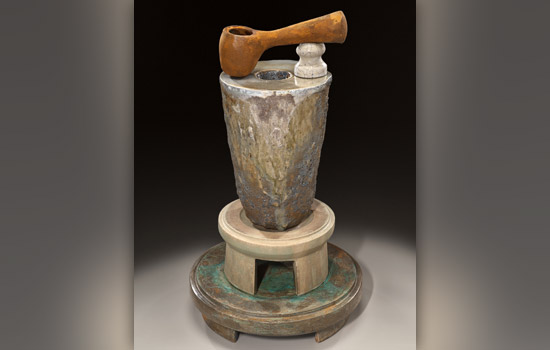‘With Fire’ explores the work by Richard Hirsch
RIT Press publishes book about a western artist with a passion for making raku
Geoff Tesch
Crucible #19, 2011 by Richard Hirsch. Wood fired stoneware, white crackle raku glaze, low fire green and tan glazes, raku patinas, 29”×16”×16”.
Raku has become my personal philosophy,
not merely a way of working, but a way of life.
—Richard Hirsch, 2011
Richard Hirsch isn’t just playing with fire, he’s earned a living from it, and in a new book by Scott Meyer, the author explores the life of this Rochester Institute of Technology professor and ceramic artist whose career spans some of the most important developments in the American Clay Movement.
With Fire: A Life Between Chance and Design is a richly illustrated book published by RIT’s Cary Graphic Arts Press. It tells the story of how Hirsch established a connection with the legendary Raku and Ohi families, whose 16th century ceramic ware influence created a lasting pedagogical and creative link to the West that continues today.
“This book is a milestone for me, inclusive of my working life as an artist,” says Hirsch. “I always stress with my students to create work that is cohesive. It’s like a symphony, where elements take major and minor roles and play off from each other. So my body of work—tripods, altar bowls, mortars and pestles, crucibles—all relate to one another, where one series leads to the next.”
Hirsch, who grew up in Manhattan, is a renowned ceramic artist and among the leaders in the contemporary clay field. He has taught for 41 years, 25 at RIT—inheriting the same “hot seat” as Bauhaus-trained master potter Frans Wildenhain, whom he studied with at RIT in the early 1970s.
“Frans did not like raku,” says Hirsch, early in the book. “But one day when he was touring Mrs. Vanderbilt Webb around the studio, he introduced me to her and said, ‘This is Richard Hirsch. He does beautiful raku work.’ I finally got his seal of approval.”
With Fire describes Hirsch’s subsequent jaunt to Japan where he demonstrated raku firing at the World Craft Conference in 1978, his meeting with the Raku family, and his early creation of raku tripod vessels.
“Then I became fascinated with the idea of stacking parts together, which resulted in my mortar and pestle series, and now with the crucible series,” Hirsch explains. “It was a creative catalyst for me; I believed I could turn this strategy into expressive gold.”
The book also includes Hirsch’s recent involvement making large-scale paintings, a series of four-by-eight foot rectangular surfaces using materials such as ceramic raw materials, dry pigment and caustic.
“I didn’t want them to be narrative, I didn’t want them to be literal, I wanted them to be non-objective,” Hirsch says. “For some time, I had wanted to return to painting, since, in a sense, painting was at the heart of my art experience.”
With Fire is available for purchase in softcover for $24.99 and hardcover for $34.99 at http://ritpress.rit.edu or by calling RIT Press at 585-475-6766. RIT Press and its co-imprint, RIT Cary Graphic Arts Press, are scholarly publishing enterprises at Rochester Institute of Technology.
About the Author
Scott Meyer is professor of ceramics at the University of Montevallo in Alabama. He has authored numerous articles and is the recipient of many awards for creative excellence and teaching. Meyer’s work with Richard Hirsch has spanned studio, kiln, writing and educational workshops. Their current work in process, “The Crucible Project,” has further defined their collaborative talents.














